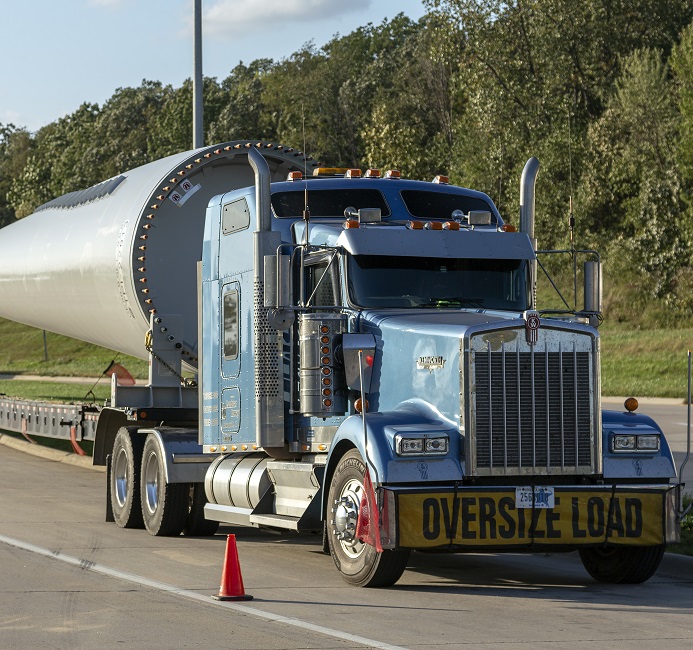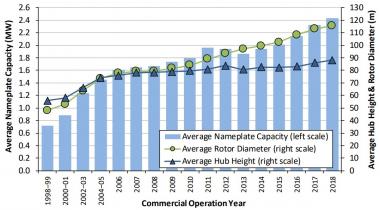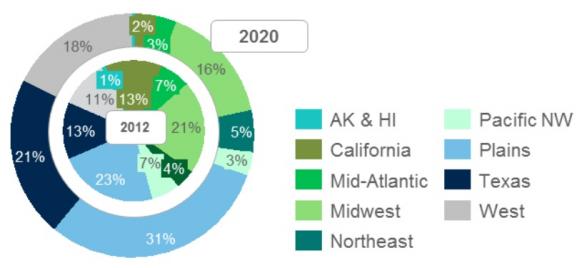Inflatable blades, airships could leapfrog transport barriers
Inflatable and adjustable blade concepts, downwind rotors and even advanced airship transport could reduce wind installation costs, industry experts told New Energy Update.

Related Articles
As growing turbine dimensions test the limits of existing transport infrastructure and logistics, developers are working on new blade and tower designs to reduce risks.
Larger wind turbines allow developers to access greater wind resources or optimize moderate wind conditions. GE, Vestas, Siemens Gamesa and Nordex have all launched turbines of capacity over 5 MW, equivalent to double the average U.S. installed turbine capacity.
US average installed turbine capacity, dimensions
(Click image to enlarge)
Source: Department of Energy's 2018 wind technologies market report, National Renewable Energy Laboratory (NREL).
Segmented blades are expected to play a key role in larger turbine deployment, reducing transport constraints and unlocking new development sites.
GE's latest 5 MW turbine blade consists of compositive blades of 77.4 metres long which can be transported in 65 metre and 12.4 meter parts.
"The advantage is it reduces transportation and logistics costs which allows us to shift larger pieces at much lower costs," Shridhar Nath, Wind Blade Technology Leader at GE, said.
Segmented blades also create modular build benefits, such as specific blade tip selection to optimize site conditions, Nath said.
"I can customize my farm...to maximize AEP [annual energy production]," he said.
More progressive blade structures could further transform turbine development, offering greater logistics, installation and operational efficiency.
U.S. researchers are currently assessing five alternative blade designs that could allow 5 MW land-based turbines with rotor diameters of 206 m, some 50 m longer than GE's latest model.
Under the Department of Energy's Big Adaptive Rotor (BAR) project, scientists at the National Renewable Energy Laboratory (NREL) and Sandia National Laboratories are using computational analysis to shortlist up to three designs for detailed design studies.
The teams will use NREL turbine design models to optimize the aero-structural design of the blades and assess the loads, buckling, and stresses, Nick Johnson, a research engineer at NREL and principal investigator on the BAR project, told New Energy Update.
"Ultimately we will use LCOE [levelized cost of energy] as a metric and will seek to minimize it," Johnson said.
New dimensions
Blade concepts assessed under the BAR project include a hollow design with a skin which is inflated on-site to achieve its full aerodynamic profile.
Researchers hope this design can alleviate transportation hurdles while maintaining reliability, Johnson said.
"The skin could be any flexible material, but would likely be some type of fabric," he said.
Another design features four or five blades that are thinner and lighter than conventional designs to reduce loading and improve transportation efficiency.
Other innovative transport solutions could include controlled bending of the blades when in transit via truck or rail, to mitigate bridge height constraints, winding roads or mountainous terrain, consultancy DNV GL said in a recent report commissioned by the Lawrence Berkeley National Laboratory.
Based on industry feedback, limited and controlled flexing of blades during rail transport could enable rail movement of 95 m and 115 m blades, the report said. Preliminary concepts have been developed, but not thoroughly tested and design and safety standards do not currently allow flexing to enable transport, it noted.
US wind project distribution by region
(Click image to enlarge)
Source: Wood Mackenzie Power and Renewables, January 2019
Alternatively, air transportation could even be used, through heavy-lift cargo airships, DNV GL said.
Designed appropriately, "lighter than air [LTA]" transport could offer high payload capacity, avoidance of ground-based infrastructure challenges, flexible landing options, and reduced operating costs, the report said.
Performance boost
Longer turbine blades also increase the risk of pitching towards the tower in strong gusts of wind. One design being assessed by the BAR team places the blades on the other side of the tower, while another features active aerodynamic controls-- much like an airplane wing--to reduce extreme loads and fatigue.
“These devices are even more important," Johnson said. "Our research is showing that pitch rates for very large blades (over 100 m) are very slow, and that active aerodynamic devices could alleviate some extreme loads, where in the past they have been mostly applied to fatigue loads.”
Advances in turbine control and analytics will also help to increase efficiency, Johnson noted.
Analytics allows operators to implement predictive and preventative maintenance strategies, reducing downtimes.
Future turbines will incorporate greater automation. Self-diagnosing turbines and real-time output maximization could soon be available on GE models, Denver Bane, Onshore Wind Services Strategy Leader at GE Renewable Energy, told the Wind Operations Dallas 2019 conference in April.
Material gains
New lighter and more flexible materials could also increase turbine efficiency.
Researchers are assessing low-cost carbon fibres originating from aerospace applications and optimized for wind turbines.
Sandia and Oak Ridge national laboratories are currently assessing the repeatability and robustness of these materials, Johnson said.
"Some of this work overlaps with BAR, in that we will use material properties from separate research to optimize the design of carbon fibre spar caps," he said.
The BAR team plans to release a series of updated analysis tools to aid blade development.
These tools will allow developers to perform "multi-fidelity optimization of blade designs," Johnson said. Features will include higher fidelity aerodynamics modelling and more accurate analysis of highly flexible blades and downwind blade designs.
“After that, a series of publications will be released on the pathways for new wind turbine blade technologies and their technoeconomic impacts on future deployments, including grid integration benefits,” he said.
By Paul Day


